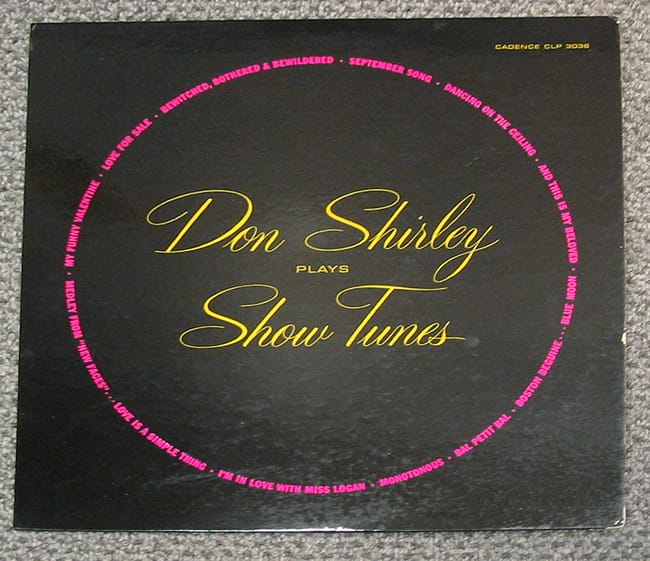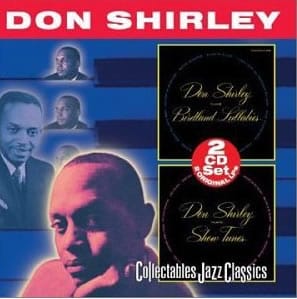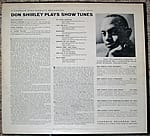 |
 |
 |
 |
Don
Shirley - Show Tunes
Cadence
CLP3036 [1960] |

IGOR STRAVINSKY: "His virtuosity is
worthy of Gods."
BENTLEY STEGNER, Chicago Sun-Times: "He can play big
round notes that fall as softly as velvet, or make
bright, little ones leap up like the tinkle of ice
in a glass."
SARAH VAUGHAN: "The most glorious sense of shading,
phrasing and balance I've ever heard."
AL "JAZZBO" COLLINS: ". . . of all the things that
might be consigned him, he is most nearly to become
the artist embodying the suffusion of the classics
and the modern. . ." |
1. My Funny Valentine
Recorded at Webster Hall, New York May 7, 1955, Bass:
Richard Davis
2. Love For Sale
Recorded at Webster Hall, New York December 20, 1955 Bass:
Richard Davis
3. Bewitched
Recorded at Capitol Studios, New York July 15, 1957,
4. September Song
Recorded at Capitol Studios, New York October 21, 1957,
Basses: Jim Bond and Kenneth Frisker
5. Dancing On The Ceiling
Recorded at Webster Hall, New York May 7, 1955, Bass:
Richard Davis
6. Medley From "New Faces":
Love Is A Simple Thing I'm In Love With Miss Logan Monotonous Bal Petit Bal
Boston Beguine. Recorded at Webster Hall, New York May 7, 1955, Bass:
Richard Davis
7. And This Is My Beloved
Recorded at Capitol
Studios, New York July 15, 1957
8. Blue Moon
Recorded at Webster Hall, New York December 20, 1955 Bass:
Richard Davis
Reissued on
Collectable Jazz Classics
COL2790

|
Back cover:
It is
impossible to describe Don Shirley's music
without analyzing Don himself; and in
analyzing, we tend to categorize because we
then have a ready frame of reference.
Although our age may not have produced the
Renaissance Man, Don Shirley probably comes
as close as any other human being in our
time to that ideal. His musical talents
could almost be overlooked from an academic
standpoint if one realizes that, in addition
to his Doctorate in Music, he is the holder
of Doctorates in Psychology and Liturgical
Arts, speaks eight languages fluently, and
is considered an expert painter as well.
Like most musicians who are true innovators,
Don Shirley the arranger-composer has always
been classified in various pigeonholes such
as "Jazz," "Classical," "Jazz-oriented
Classical" or "Classically-oriented Jazz,"
but always half-heartedly and with many
reservations. His work cannot be catalogued
in a particular school of musical
composition. Each song is more than just a
new arrangement; it is a composition in
itself, using the familiar song melody as
part of its framework. Though the melodic
and harmonic structure of a song by Jimmy
McHugh may suggest to Don Nineteenth Century
romanticism and not Twentieth Century
Hollywood, the melody is always there
forming the basic fabric of his arrangement,
at the same time inspiring counter-melodies.
Don's piano style reflects many different
influences, yet these are all governed by
his own inscrutable and unyielding
individuality. He may suddenly quote the
familiar style of Garner or Ellington or
Shearing. Still these polite tributes are
never more than just that, for this is one
more device of Don's using his music to
create the atmosphere he chooses. "There are
three ways to enjoy or to interpret music,
from a listening point of view: emotionally,
intellectually, and a combination of the
two. I have tried to utilize all three,
contingent upon the quality of the tune
chosen." His choice of using the piano as a
stringed rather than as a percussion
instrument gives him a flexible and
marvelously expressive voice to combine
emotion and intellect in the subtlest way.
The extent of Don's formal training is
clearly revealed in his fabulous technic. He
began playing piano at the age of 21/2, and
by the time he was 9 he had been invited to
study at the Leningrad Conservatory, where
he was to spend a great part of his youth.
And yet he was to abandon the piano while
still quite young.
It was while in Chicago as a psychologist
that Don "tripped" back into a musical
career. He was given a grant to study the
'relationship, if any, between music and a
juvenile crime wave which had suddenly
broken out in the early 1950's. Working in a
small club there, he used his knowledge and
skill to perform experiments in sound,
whereby he proved that certain tonal
combinations affected the audience's
reactions. No one in the audience knew of
his experiment, or that students had been
planted among them to gauge their reactions.
But. Don Shirley the pianist became a
sensation. Appearances in New York followed,
notably at the Basin Street, where Duke
Ellington first heard him. Here started
their warm friendship which was highlighted
by Don's performance in 1955 of the premiere
of the Duke's Piano Concerto at Carnegie
Hall with the NBC Symphony of the Air. An
appearance on the Arthur Godfrey Show
Lunched his career nationwide.
Don has composed three symphonies, two piano
concerti, a cello concerto, three string
quartets, a one-act opera, works for organ,
piano and violin, a symphonic tone poem
based on "Finnegan's Wake" and a set of
"Variations" on the legend of Orpheus in the
Underworld.
All indications seem to be that Don
Shirley's favorite career is that of
musician, and his material that of our
country, our time, and the richness of a
many-faceted personality.
|
An album of
show tunes seems quite appropriate for one
whose first public performance was at the
age of three. In those early years of his
child prodigy career, Don solved the problem
.of comprehending technical musical terms by
associating specific sounds with certain
inanimate objects. When he heard the key of
'E Flat Major', for example, the young
pianist immediately thought of a bright red
apple. 'A Major' was a key related to a pink
church, and 'D Flat Major' to the black of
railroad tracks. 'B Major' was the lovely
blue of Turquoise Bay in his native Montego,
Jamaica—and when one hears this same color
mood developed in Don's 'B Major.' version
of Dancing On The Ceiling, the
listener cannot help but observe that this
method was as successful as it was
ingenious.
Taken from the 1932 British production
Evergreen, Dancing On The Ceiling was
Don's initial effort in the popular idiom.
It is really more of a composition than an
arrangement—more Don Shirley than Richard
Rodgers. The bass part, with a theme of its
own, could serve as the complete melody if
inverted and played in one of the upper
voices. Notice how the same bass resembles a
harp in Don's treatment of Blue Moon.
This song, which is the only Rodgers and
Hart work never to appear in either a film
or musical, shows us Don Shirley the
impressionist. An educated musical ear may
detect in the song's development a strong
influence of Ravel—including a direct quote
from the French composer's "Gaspard de la
Nuit."
The curtain raiser to this show tune album,
My Funny Valentine was introduced in the
1937 Rodgers and Hart Musical, Babes In
Arms. It is performed here without use
of the pedal —a unique feat which adds
immensely to the clarity of the work.
Don's arrangement of September Song,
from Kurt Weill's first American success,
Knickerbocker Holiday (1938), was
inspired by Walter Huston's interpretation.
The treatment here is a beautiful portrayal
of old age through the medium of the
piano—hence the Delius-like formlessness,
implying the lack of form in the wisdom of
old age.
New Faces of 1952 is performed as a college
of wit and invention. In Monotonous
and Bal Petit Bal, we hear a clever
imitation of Earths Kitt enunciating the
vibrata quality of her voice. Another
friendly mime is that of Robert Clary's
portrayal of the little boy who sings I'm
In Love With Miss Logan. Arthur Siegel's
Love Is A Simple Thing is effectively
used as both an introduction and conclusion
to this all-things-to-all-men medley, which
includes within its boundaries Boston
Beguine, He Tales Off His Income Tax,
and Penny Candy. |
|
|
|
|

